

- #Splunk enterprise security use cases update#
- #Splunk enterprise security use cases software#
A field action initiates a new search on another dashboard in Enterprise Security, using the selected field as a filter. Click the arrow next to the Destination IP Address field to initiate a field action.
Begin the investigation into the host by investigating the Destination IP Address. The Urgency assigned to this notable event was partially calculated from the priority assigned to the host.  Review several fields for history about the host or hints of activity. The fields are populated with data correlated from the logs of one or more data sources and asset and identities collections. Review the information provided with the notable event.Įach notable event has a selection of fields that provide contextual information about the issue. Click the arrow next to a notable event to expand the view and display the details of the notable event. The Description field is a summary of the conditions a correlation search must find for you to create a notable event. Click Save changes to return to the Incident Review dashboard.
Review several fields for history about the host or hints of activity. The fields are populated with data correlated from the logs of one or more data sources and asset and identities collections. Review the information provided with the notable event.Įach notable event has a selection of fields that provide contextual information about the issue. Click the arrow next to a notable event to expand the view and display the details of the notable event. The Description field is a summary of the conditions a correlation search must find for you to create a notable event. Click Save changes to return to the Incident Review dashboard. #Splunk enterprise security use cases update#
Update the Comment field as required by your company security policy. Change the Status field to In Progress, and assign your user as the Owner. Click the Edit all matching events link on the top left of the table view. Use the check box to select the first notable event. 
To assign the notable event to your user account: The Incident Review dashboard displays only the Critical notable event that was created for a High Or Critical Priority Host With Malware Detected.Īssigning notable events begins a record of activity that you can use for notes and time tracking, and lets other analysts know that an issue is being investigated.
Remove other notable events from the view by deselecting all other Urgency levels until only Critical remains. Start the investigation by looking at the notable event labeled Critical. The event urgency is calculated based on the priority assigned to a host or asset and the severity assigned to the correlation search. The search for High Or Critical Priority Host With Malware Detected ranges over several Urgency levels. Because the link to Incident Review was initiated from another dashboard panel, the Incident Review dashboard opens with a search for High Or Critical Priority Host With Malware Detected notable events and scoped to a narrow timeframe. Use the Incident Review dashboard to find, assign, analyze, and update notable events. To drill down into those numbers, select the peak count on the sparkline to open another browser window and drill down to the Incident Review dashboard. The panel shows that the number of High Or Critical Priority Host With Malware Detected notable events had a sudden spike. In the Top Notable Events panel, you see the count of notable events sorted by the correlation search name. 
In the Notable Events Over Time panel, you see a spike in activity labeled "endpoint." The endpoint domain represents host based security, so you know there was a large spike in suspicious activity on the network hosts. Use the Notable Events By Urgency panel to determine which issue needs your immediate attention. On any given day, there might be tens or hundreds of notable events represented on the Security Posture dashboard. When a notable event is created, it represents a potential issue or threat requiring a review and, depending upon the outcome of the review, an investigation. A notable event is the result of a security-oriented correlation search that scans the indexed logs until a match is found. The dashboard represents a summary of all notable event activity over the last 24 hours.
#Splunk enterprise security use cases software#
Verify that logs from an IDS/IPS tool, web proxy software or hardware, and/or an endpoint security product are indexed on a Splunk platform instance.īegin by reviewing the Security Posture dashboard.Verify that a Splunk platform instance with Splunk Enterprise Security is installed and configured.Using the dashboards together, you can build a workflow for investigating threats by reviewing the results, isolating the events that require attention, and using the contextual information provided to drill down into the issue. Using Enterprise Security to find MalwareĮnterprise Security provides statistics and interesting events on security domain specific dashboards.








 0 kommentar(er)
0 kommentar(er)
